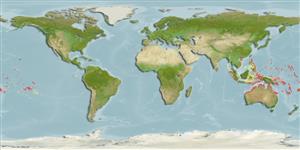Teleostei (teleosts) >
Gobiiformes (Gobies) >
Gobiidae (Gobies) > Gobiinae
Etymology: Eviota: No etymology given, suggested by Christopher Scharpt: from Latin 'eu' for 'true' and 'iota' for anything very small, in combination 'truly very small' referring to it as being the smallest vertebrate at the time it has benn described by Jenkins (thus, making the suggestion by Scharpt plausible..
More on authors: Jordan & Seale.
Environment: milieu / climate zone / depth range / distribution range
Ecology
Marine; reef-associated; depth range 0 - 3 m (Ref. 107299). Tropical; 20°N - 24°S
Pacific Ocean: Ryukyu Islands, Japan; south to Timor Sea and the Great Barrier Reef; east to Oceania and Tuamotus.
Size / Weight / Age
Maturity: Lm ? range ? - ? cm
Max length : 1.8 cm SL male/unsexed; (Ref. 1602)
Dorsal
spines
(total): 7;
Dorsal
soft rays
(total): 8-9;
Anal
spines: 1;
Anal
soft rays: 6 - 8. This species is distinguished by the following characters: cephalic sensory-canal pore system lacking only the IT pore (pattern 2); branched pectoral-fin rays; dorsal/anal-fin formula is 9/8; the fifth pelvic-fin is ray small or rudimentary (about 10% of 4th pelvic ray); caudal fin has rows of small dark spots set close together on rays, membranes dark; presence of a small dark spot over preural centrum associated with last subcutaneous bar may be present; the scale edges are not dark (Ref. 107299).
Occurs on algal mats of shallow exposed reefs.
Life cycle and mating behavior
Maturity | Reproduction | Spawning | Eggs | Fecundity | Larvae
Benthic spawner.
Myers, R.F., 1991. Micronesian reef fishes. Second Ed. Coral Graphics, Barrigada, Guam. 298 p. (Ref. 1602)
IUCN Red List Status (Ref. 130435)
Threat to humans
Harmless
Human uses
More information
ReferencesAquacultureAquaculture profileStrainsGeneticsElectrophoresesHeritabilityDiseasesProcessingNutrientsMass conversion
Tools
Warning: mysqli::__construct(): (08004/1040): Too many connections in /var/www/html/includes/speciessummary.lib.php on line 2414
Can't connect to MySQL database fbquizv2. Errorcode: Too many connections
